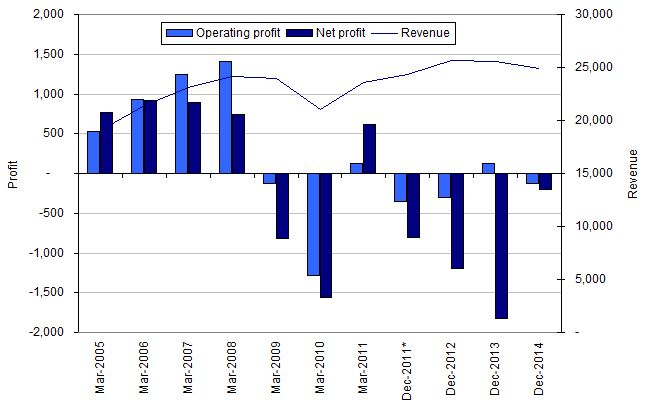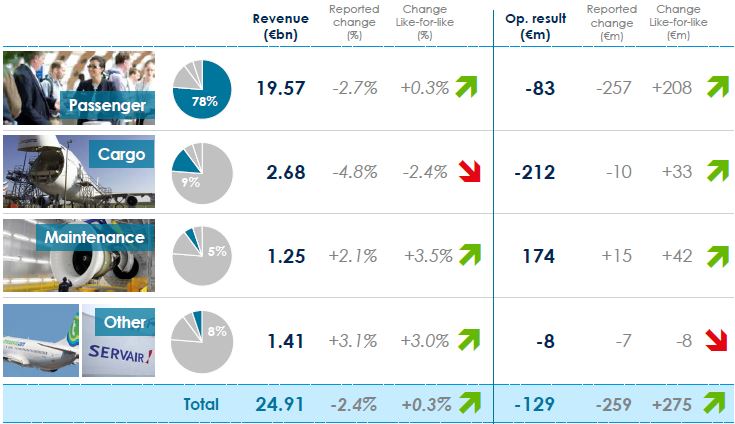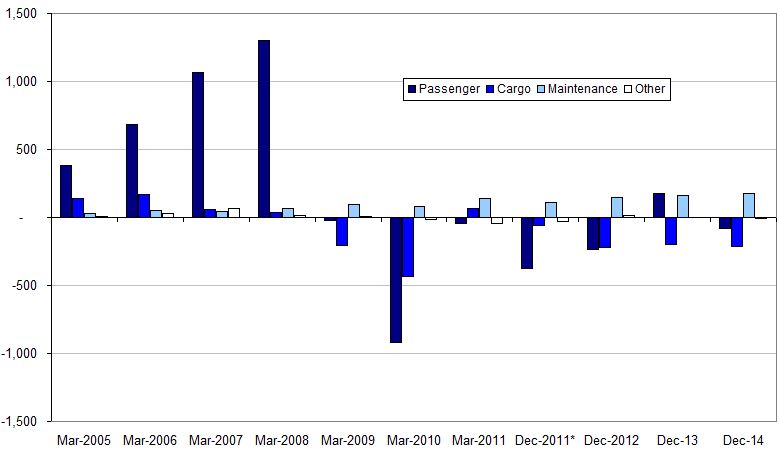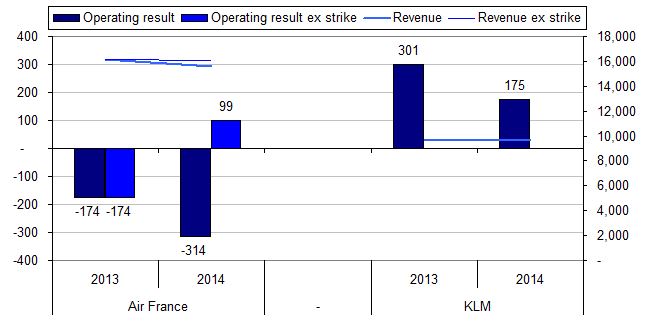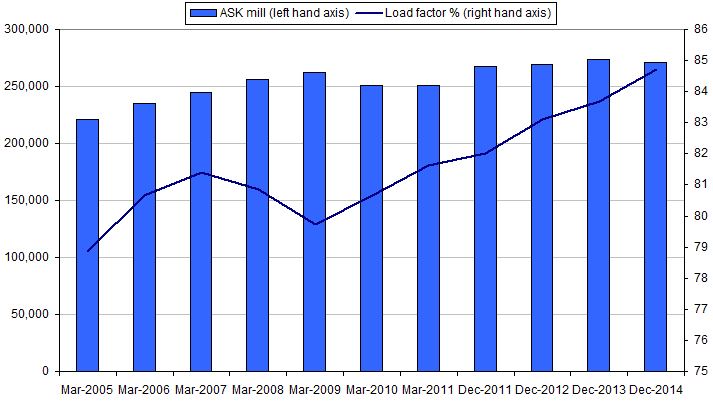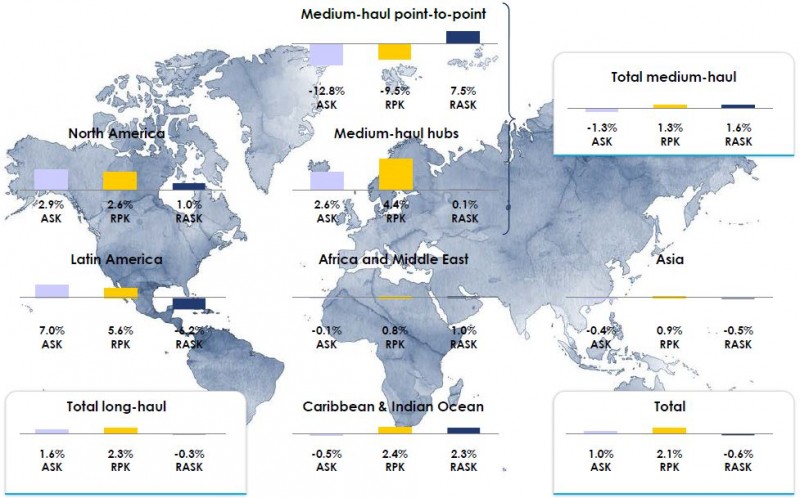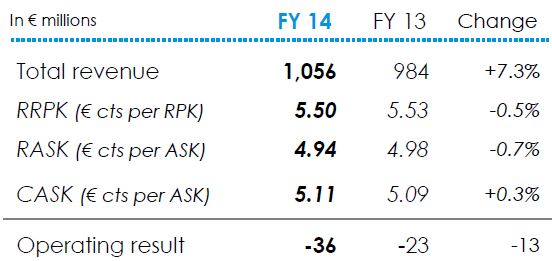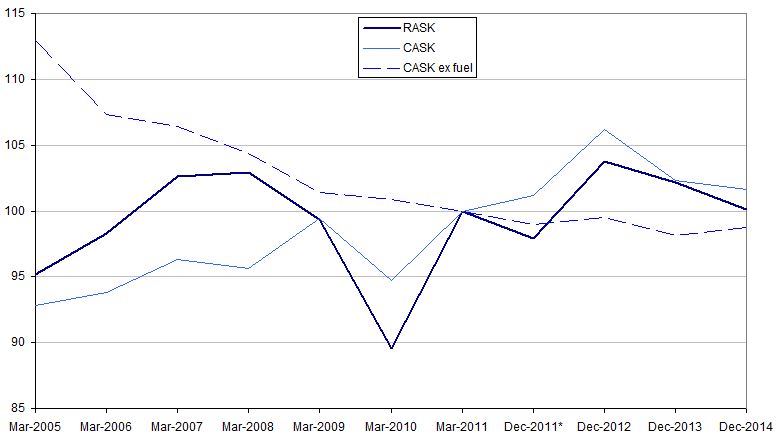Air France-KLM back to operating loss; warns lower fuel may be offset by low unit revenue & currency
Air France-KLM marked its first decade with a return to loss at the operating level in 2014. A pilot strike over the development of LCC Transavia took EUR425 million off the operating result, which would otherwise have been positive and higher than in 2013. The dispute was settled and Air France-KLM's generally good history of labour relations suggests that it is unlikely to be repeated in 2015.
Nevertheless, the settlement required management to compromise its plans for Transavia and this may make it harder to push through further important restructuring across the group. Moreover, even without the impact of the strike, the year was characterised by ongoing unit revenue weakness, particularly in long-haul markets such as Latin America.
Air France-KLM does not see this market environment improving. Indeed, it has suggested that the benefits of lower fuel prices in 2015 may all be eaten up by falling unit revenue and currency movements. The group has abandoned its previous EBITDAR growth targets, but is cutting its investment plans and is accelerating its unit cost reduction. There is more turbulence ahead.
Air France-KLM pilots strike sends operating result back into loss in 2014
In 2014, Air France-KLM's net result improved to a loss of EUR198 million compared with a loss of EUR1,827 million in 2013. However, the reported result was distorted by a number of positive non-operating items, including changes to KLM pension plans, the sale of part of the group's holding in Amadeus and a lower tax charge.
Air France-KLM's operating result, which better reflects the performance of the business, fell to a loss of EUR129 million in 2014 from a profit of EUR130 million in 2013. The operating result without the impact of the pilots strike in 2014 would have been a profit of EUR296 million, more than double last year's result, but still only at a margin of 1.2%. Group revenue fell by 2.4% to EUR24,912 million.
Currency movements lowered both revenues and costs, for a net negative impact on the operating result of EUR158 million.
Air France-KLM financial highlights 2014
|
EUR million except where stated |
2013 |
2014 |
Change |
|---|---|---|---|
|
Revenue |
25,520 |
24,912 |
-2.4% |
|
EBITDAR |
2,768 |
|
-11.1% |
|
EBITDA |
1,855 |
1,589 |
-14.3% |
|
Operating result |
130 |
-129 |
-199.2% |
|
Operating profit % |
0.5 |
-0.5 |
+1.0ppt |
|
Net profit |
-1,827 |
-198 |
-89.2% |
|
Net debt |
5,348 |
5,407 |
1.1% |
|
Equity |
2,290 |
-632 |
-127.6% |
The net loss in 2014 was Air France-KLM's fourth in a row and its sixth in the past seven years. The operating loss was the fifth in seven years, although the trend would have continued upwards had it not been for the strike.
Although the group achieved increases in operating profit in the early years after its creation in 2004, reporting an operating margin of 5.8% in the year to Mar-2008, it has struggled to restore a profitable track record since the global financial crisis of 2008/2009.
Air France-KLM revenue, net profit and operating profit (12 month period to date shown, EUR million) 2005-2014
Air France-KLM's net debt climbs once more
The group's lower profitability led to a reduction in operating cash flow from EUR1.5 billion in 2013 to EUR1.0 billion in 2014. There was also an increase in net capital investment, after sale and leaseback proceeds, from EUR0.9 billion in 2013 to EUR1.2 billion in 2014.
As a result of lower operating cash flow and higher investment spend, the group's year end net debt increased for the first time in four years, from EUR5,348 million to EUR5,407 million. Gross liquidity fell from EUR4.2 billion at the end of 2013 to EUR3.5 billion at the end of 2014, equivalent to 52 days of revenue.
Net debt reduction remains a key priority for Air France-KLM, which has set an end 2015 target to cut it to EUR5 billion. Its capital expenditure plans have been cut by EUR300 million in each of 2015 (total spend now planned to be EUR1.6 billion) and 2016 (EUR1.9 billion). Planned investment in 2017 remains EUR2.2 billion, similar to the levels of the years immediately before the global financial crisis and requiring significant improvements in profitability.
Air France-KLM development of net debt and cash 2005-2014
Passenger segment was hardest hit by pilots strike
The group's passenger segment, representing 78% of revenue, suffered the biggest drop in its operating result. Its 2014 loss of EUR83 million was EUR257 million below its 2013 result. Air France-KLM says that the 2014 result was EUR208 million better than the previous year's on a like for like basis, which excludes the impact of currency movements, the pilots strike and other one-offs in 4Q2014.
The cargo segment continued to struggle in 2014, recording an operating loss of EUR212 million, down by EUR10 million from 2013 as reported, although this was EUR33 million better on a like for like basis. The maintenance segment remains the group's best performing and most consistent segment, with an operating profit of EUR174 million, which was EUR15 million better than in 2013.
The other segment, which includes the catering business Servair and the LCC Transavia, reported an operating loss of EUR8 million in 2014, compared with a loss of EUR1 million in 2013. Transavia's operating loss widened to EUR36 million in 2014 from a loss of EUR23 million in 2013.
Air France-KLM revenue and operating result by business segment 2014
Even after adjusting for the strike and other one-offs in 2014, the passenger segment remains significantly short of its operating results in the first four years after the merger.
The cargo segment is also well below previous levels in profit terms, while the maintenance segment is the most consistent performer. Nevertheless, the passenger segment is the main driver of the group result.
Air France-KLM operating profit by business segment (12 month period to date shown, EUR million) 2005-2014
Losses in medium-haul passenger network narrow, but profit in long-haul falls
Adjusting for the impact of the strike (but not for currency and other one-offs) the operating loss of EUR83 million in the passenger segment would have been a profit of EUR289 million. By network, estimated figures published by Air France-KLM show that profits in the long-haul business decreased from c.EUR800 million in 2013 to c.EUR730 million in 2014.
Medium-haul losses narrowed as significant restructuring took effect. According to the estimated figures, the loss in the medium-haul hub feed network narrowed from c.EUR400 million in 2013 to c.EUR320 million in 2014. This business should really be viewed together with the long-haul operation, which it is primarily designed to feed.
The combined result of long-haul with medium-haul hub feed, a profit of c.EUR410 million in 2014, was little changed from the c.EUR400 million figure estimated for 2013. At its Investor Day on 11-Sep-2014, Air France-KLM presented a chart implying that it anticipated a significantly higher result in 2014 for these two parts of its network. It seems that long-haul unit revenues were weaker than expected and deteriorated in 2H2014.
The medium-haul point to point result improved from a loss of c.EUR220 million to a loss of c.EUR120 million. This was slightly better than the loss of EUR140 million anticipated by the company at its Sep-2014 Investor Day. Air France-KLM is still targeting breakeven for this part of the network by 2017.
See related report: Air France-KLM's new plan to grow LCC Transavia has taken too long; a union confrontation looms
Air France-KLM Passenger segment: estimated operating result by network for excluding impact of pilots strike
KLM was more profitable than Air France, but operating result falls
For the first time since the group was created, Air France-KLM has reported separate figures for revenue and operating result for the two major operating airlines within the group (although KLM separately reports its own financial results each year).
See related report: KLM: a decade after Air France merger, the smaller, but more profitable partner also needs cost cuts
Air France's revenue fell by 3.4% to EUR15,582 million and its operating result fell from a loss of EUR174 million in 2013 to a loss of EUR314 million in 2014 (margin -2.0%). Without the strike impact, the fall in revenue would only have been 0.4% and the operating result would have been a profit of EUR99 million (margin +0.6%).
KLM remains a more profitable business than Air France, but its operating profit declined from EUR301 million in 2013 (margin 3.1%) to EUR175 million in 2014 (margin 1.8%). KLM's revenue was almost flat (-0.5%) at EUR9,643 million for 2014.
Under the group's Perform 2020 programme, Air France is targeting net cost savings of EUR650 million by 2017 (EUR140 million in 2015) and KLM is targeting EUR390 million (EUR90 million in 2015).
Air France and KLM operating result (left hand axis) and revenue (right hand axis), EUR million, 2013 and 2014
ASKs down 0.6% in 2014 as load factor reaches a new high
The Air France-KLM group (excluding Transavia) reduced ASKs by 0.6% in 2014, but increased RPKs by 0.5% so that passenger load factor reached another new high level of 84.7%. This load factor was 0.9ppt higher than in 2013 and 5.0 ppts higher than in the year to Mar-2009.
It compares favourably with the AEA average load factor for 2014 of 80.6% and is one indicator on which Air France-KLM leads the European Big Three legacy airline groups (IAG's 2014 load factor was 80.3% and the Lufthansa group's was 80.1%).
The group has maintained a cautious growth strategy since the financial crisis, increasing ASKs at an average growth rate of less than 1% pa since the year to Mar-2009. This has helped it to build high load factors
Air France-KLM development of capacity (ASK million) and load factor (%) (12 month period to date shown) 2007-2014.
Like for like, RASK was the weakest on Latin America network
Without the strike, ASK growth would have been +1.0% in 2014. Unit revenue (RASK) in the passenger segment fell by 2.0% in 2014, but the fall would have been 0.9% at constant currency and 0.6% on a like for like basis (at constant currency and before the impact of the strike and other one-offs). The premium cabins enjoyed a 3.0% increase in like for like RASK, while the economy cabin's like for like RASK fell by 0.9%.
The group's overall like for like RASK performance was up in 1H, but fell in 2H2014, coinciding with the fall in oil prices. Air France-KLM CEO Alexandre de Juniac told analysts at a presentation to discuss the FY2014 results that ongoing downward price pressure was due to a number of factors. These include competition, the economic outlook in certain regions (especially Latin America), world events and the trend in Europe towards a "more leisure-like" market.
The development of like for like ASKs, RPKs and RASK is shown in the chart below.
Capacity reduction was focused on the medium-haul network (like for like ASK -1.3%) in particular in the medium-haul point to point network (ASK -12.8%), where capacity was reduced in favour of growth at Transavia (not included in the ASK data reported in the chart). The strong capacity cut in medium-haul point to point helped to drive a 7.5% increase in like for like RASK in this part of the network. RASK increased by 1.6% like for like in the medium-haul network overall.
In long-haul, like for like ASK growth was 1.6% and RASK was down slightly (-0.3%). The strongest growth was in Latin America (ASK +7.0%), which also had the weakest RASK performance (-6.2%). The group's North America network achieved growth in both ASKs (+2.9%) and RASK (+1.0%), reflecting the benefits of the trans-Atlantic joint venture with Delta.
Air France-KLM development of like for like* capacity (ASK), traffic (RPK) and unit revenue (RASK) by region 2014
Expanding partnerships in Asia is a key objective
On its Asia network, Air France-KLM's 2014 ASKs and RASK were only slightly down on their levels of 2013, when it had increased capacity by 4.3% and RASK had fallen by 1.3% in the region. Tighter capacity management appears to have benefited unit revenues in Asia, also helped by the group's growing partnerships.
Air France-KLM has joint ventures with China Southern and China Eastern and a codeshare agreement with Etihad, but Mr de Juniac plans to increase the use of partners and JVs. "We have to have the same grip in the Asian market as we have on the North Atlantic", he said at the results presentation.
Air France-KLM group revenue was down 2.4% in 2014
Group revenue fell by 2.4% in 2014, more than the reduction in ASKs, mainly tracking the performance of passenger revenue (see table below). Currency movements depressed revenue by EUR279 million during the year (although the impact was positive to the extent of EUR98 million in 4Q2014). Like for like revenue growth was +0.3%.
Cargo revenue fell by 4.8%, more than the 2.3% drop in cargo capacity (available tonne kilometres), reflecting weak demand and the pilots strike.
Maintenance revenue grew by 2.1% and other revenue grew by 3.1%, but these two growth areas accounted for only 11% of group revenue for 2014.
Air France-KLM revenues (EUR million) 2013 and 2014
|
|
2013 |
2014 |
Change |
% of 2014 revenue |
|---|---|---|---|---|
|
Passenger |
20,112 |
19,570 |
-2.7% |
79% |
|
Cargo |
2,816 |
2,681 |
-4.8% |
11% |
|
Maintenance |
1,225 |
1,251 |
2.1% |
5% |
|
Other |
1,367 |
1,410 |
3.1% |
6% |
|
Total |
25,520 |
24,912 |
-2.4% |
100% |
Costs were down 1.3%
Total operating costs were reduced by 1.3% in 2014, more than the ASK capacity cut, but less than the fall in revenue. Currency movements lowered costs by EUR121 million during the year (in 4Q2014, the impact on costs reversed and increased them by EUR163 million). On a like for like basis, costs fell by 0.8%.
Fuel costs fell by 3.9% and ex fuel costs fell by 0.4%. Labour was the biggest cost item (29% of the total), but labour expense fell by 2.2%, mainly reflecting lower headcount.
Air France-KLM operating costs 2013 and 2014, EUR million
|
|
2013 |
2014 |
Change |
% of 2014 costs |
|---|---|---|---|---|
|
Aircraft fuel |
6,897 |
6,629 |
-3.9% |
27% |
|
Chartering costs |
455 |
438 |
-3.7% |
2% |
|
Aircraft operating lease costs |
913 |
873 |
-4.4% |
4% |
|
Landing fees and en route charges |
1,839 |
1,840 |
0.1% |
7% |
|
Catering |
589 |
591 |
0.3% |
2% |
|
Handling charges and other operating costs |
1,405 |
1,476 |
5.1% |
6% |
|
Aircraft maintenance costs |
1,303 |
1,356 |
4.1% |
5% |
|
Commercial and distribution costs |
852 |
870 |
2.1% |
3% |
|
Salaries and related costs |
7,482 |
7,316 |
-2.2% |
29% |
|
Amortization and depreciation |
1,566 |
1,589 |
1.5% |
6% |
|
All other |
2,099 |
2,081 |
-0.9% |
8% |
|
Total |
25,400 |
25,059 |
-1.3% |
100% |
|
Costs ex fuel |
18,503 |
18,430 |
-0.4% |
73% |
Labour productivity improvements in 2014
As the biggest cost category, labour is a key area for further cost improvements. In 2014, there were reductions in headcount and in labour cost per employee. In addition, according to our calculations, there was an improvement in total ATK per employee and a reduction in employee cost per ATK.
The only labour productivity measure to deteriorate in 2014 was revenue per employee, which was down by 0.6%. However, the small decline was due to the strike impact and this indicator was 10% higher in 2014 than in 2011.
Pension-related changes (lower discount rate) are expected to have a negative impact on reported costs of EUR100 million in 2015 (but no additional cash impact), but Air France-KLM management is focusing on further productivity improvements. The group has extended a general pay freeze and Air France is implementing a new voluntary redundancy plan to reduce headcount by a further 800 full time equivalents.
Both Air France and KLM are also discussing amendments to collective labour agreements with their various unions. As the largest cost category, and one over which management has some control, labour cost efficiency improvements will be crucial to restoring the group's profitability.
Air France-KLM labour productivity measures 2011 to 2014
|
|
2011* |
2012 |
2013 |
2014 |
Change 2014 vs 2013 |
|---|---|---|---|---|---|
|
Total full time equivalent headcount |
102,012 |
100,744 |
96,417 |
94,666 |
-1.8% |
|
Total labour cost EUR mill |
7,460 |
7,660 |
7,482 |
7,316 |
-2.2% |
|
Employee cost per employee (EUR) |
73,129 |
76,034 |
77,600 |
77,282 |
-0.4% |
|
ATK per employee |
429 |
430 |
448 |
451 |
0.6% |
|
Employee costs per ATK (EUR) |
17.0 |
17.7 |
17.3 |
17.1 |
-1.0% |
|
Revenue per employee |
238,825 |
254,437 |
264,684 |
263,157 |
-0.6% |
Transavia's growth continues, but its operating loss widens
Transavia capacity, in ASK, increased by 8.3%, driven by a 21% increase in France (Transavia traffic data are not included in the group's traffic figures). In the Netherlands, Transavia's capacity was broadly stable overall, but it continued to move its business model towards scheduled flights (ASK up 12%) and away from charter (ASK down 4%). Transavia's load factor dipped slightly (-0.2 ppts) to 89.8% and its revenue per ASK (RASK) slipped by 0.7%.
This unit revenue performance was reasonably robust given the strong capacity growth and a price competitive market, but Transavia's operating result was nevertheless lowered both by the fall in RASK and by a 0.3% increase in cost per ASK (CASK). The company attributed the CASK increase to the ramp up of new routes in France.
Air France-KLM continues to aim for a breakeven result for Transavia in 2017, by when it plans to grow the LCC's fleet to 61 aircraft, from 45 in 2014 (excluding short term summer leases). This compares with a previous target of 100 aircraft in summer 2017, announced at Air France-KLM's investor day in Sep-2014 before plans to launch a pan-European wing of Transavia were abandoned as part of the settlement to the dispute with pilots. As CAPA has suggested in previous analysis, this leaves Transavia sub-scale and with too limited a geographical scope.
See related reports:
- Transavia part 1. Pilots agree vital growth in France; Air France to rue end of pan-Euro LCC plan
- Transavia part 2: still constrained by unions and forced into high degree of overlap with Air France
Transavia key results 2014
Unit cost targets met, but other financial targets have proved to be slippery
Although Air France-KLM reports that it achieved the unit cost reduction targets set under its Transform 2015 restructuring programme, reducing ex fuel unit cost by 7% from 2011 to 2014 (at constant currency), it has failed to transform its profitability. It seems that unit revenue weakness consistently surprises Air France-KLM.
The group's EUR1,589 million EBITDA figure for 2014 would have been EUR2,014 million without the strike impact. This adjusted figure is EUR159 million better than in 2013, but the rate of improvement is slowing: 2013's result had been EUR461 million better than the equivalent number for 2012.
Moreover, Air France-KLM's targets keep slipping.
Its Transform programme originally targeted 2014 EBITDA in a range of EUR2.5 billion to EUR3.0 billion, before this was lowered to EUR2.5 billion in Feb-2014 and again in Jul-2014 to a range of EUR2.2bn to EUR2.3bn. In Oct-2014, Air France-KLM said the strike could hit EBITDA by as much as EUR500 million, implying a revised EBITDA range EUR1.7bn to EUR1.8bn.
The last cut to the target was on 18-Dec-2014, when the group lowered it by an additional EUR200 million, suggesting a figure between EUR1.5bn and EUR1.6bn. With less than two weeks of the year left, Air France-KLM had finally got to grips with its annual profit outlook. The reported figure is at the upper end of this range, but little more than half of the upper end of the original range.
Air France-KLM's balance sheet targets have also slipped. It originally set a net debt target of EUR4.5 billion for Dec-2014, but then pushed this out to Dec-2015.
Having now reported Dec-2014 net debt of EUR5.4 billion, its new target for Dec-2015 is "around" EUR5 billion. Looking further out, its previous target to reduce the ratio of adjusted net debt/EBITDAR to "below 2.5" in 2017 (this rose from 4.2 in 2013 to 4.7 in 2014) has subtly changed to "around 2.5".
Air France-KLM: no profit target for 2015
In 2015, Air France-KLM plans ASK growth, excluding the impact of last year's strike, of 1.6% for the total group. This can be broken down as 1.1% for the network airlines (Air France, Hop and KLM) and 8% for Transavia (including 30% growth in France). The network airlines' ASK growth can be further broken down as 1.5% on long-haul, 2% on medium-haul hub feed and a cut of 11% on medium-haul point to point.
The company has abandoned its target to grow EBITDAR by 8% to 10% pa from 2013 to 2017 (it fell by 11% in 2014). It has not set any kind of profit target for 2015, but thinks that lower fuel costs could be almost completely offset by unit revenue pressure and currency impacts. In this context, it has correctly identified further cost reduction as the only lever within its control that it can use to improve profitability.
The group plans to strengthen its unit cost reduction target for 2015-2017 from a range of 1% to 1.5% pa to "an average of 1.5%" pa. However, for 2015, its target is a more modest reduction in unit costs of 1% to 1.3%, leaving more to do in 2016 and 2017.
Given its track record of sliding targets and the ongoing difficulties it faces in shoring up RASK, it is becoming increasingly important that Air France-KLM should not just meet its latest financial targets, but improve on them.
Air France-KLM Passenger segment - index of operating cost per ASK and scheduled revenues per ASK (each indexed to 100 in year to March 2010)
